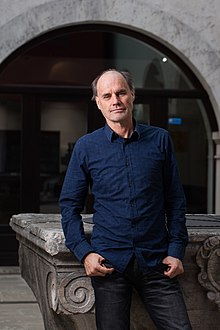
Tomaž (Tomo) Pisanski is a Slovenian mathematician working mainly in discrete mathematics and graph theory. He is considered by many Slovenian mathematicians to be the "father of Slovenian discrete mathematics."
In the mathematical field of graph theory, an automorphism is a permutation of the vertices such that edges are mapped to edges and non-edges are mapped to non-edges. A graph is a vertex-transitive graph if, given any two vertices v1 and v2 of G, there is an automorphism f such that
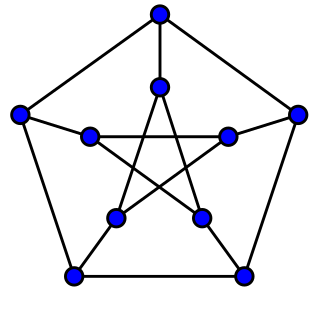
In the mathematical field of graph theory, a graph G is symmetric if, given any two pairs of adjacent vertices u1—v1 and u2—v2 of G, there is an automorphism

University of Primorska is a public university in Slovenia. It is located in Koper, Izola, and Portorož and is named for the Slovenian Littoral region, where it is located.

In the mathematical field of graph theory, a semi-symmetric graph is an undirected graph that is edge-transitive and regular, but not vertex-transitive. In other words, a graph is semi-symmetric if each vertex has the same number of incident edges, and there is a symmetry taking any of the graph's edges to any other of its edges, but there is some pair of vertices such that no symmetry maps the first into the second.

In the mathematical field of graph theory, the Gray graph is an undirected bipartite graph with 54 vertices and 81 edges. It is a cubic graph: every vertex touches exactly three edges. It was discovered by Marion C. Gray in 1932 (unpublished), then discovered independently by Bouwer 1968 in reply to a question posed by Jon Folkman 1967. The Gray graph is interesting as the first known example of a cubic graph having the algebraic property of being edge but not vertex transitive.
In graph theory, the Lovász conjecture (1969) is a classical problem on Hamiltonian paths in graphs. It says:

In the mathematical field of graph theory, the Coxeter graph is a 3-regular graph with 28 vertices and 42 edges. It is one of the 13 known cubic distance-regular graphs. It is named after Harold Scott MacDonald Coxeter.

In the mathematical field of graph theory, a distance-transitive graph is a graph such that, given any two vertices v and w at any distance i, and any other two vertices x and y at the same distance, there is an automorphism of the graph that carries v to x and w to y. Distance-transitive graphs were first defined in 1971 by Norman L. Biggs and D. H. Smith.

Cheryl Elisabeth Praeger is an Australian mathematician. Praeger received BSc (1969) and MSc degrees from the University of Queensland (1974), and a doctorate from the University of Oxford in 1973 under direction of Peter M. Neumann. She has published widely and has advised 27 PhD students. She is currently Emeritus Professor of Mathematics at the University of Western Australia. She is best known for her works in group theory, algebraic graph theory and combinatorial designs.
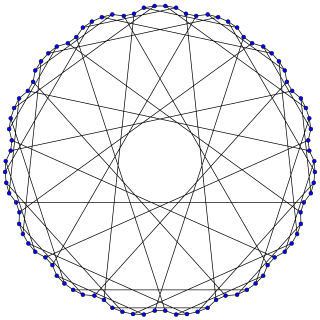
In the mathematical field of graph theory, the Foster graph is a bipartite 3-regular graph with 90 vertices and 135 edges.

In the mathematical field of graph theory, the Möbius–Kantor graph is a symmetric bipartite cubic graph with 16 vertices and 24 edges named after August Ferdinand Möbius and Seligmann Kantor. It can be defined as the generalized Petersen graph G(8,3): that is, it is formed by the vertices of an octagon, connected to the vertices of an eight-point star in which each point of the star is connected to the points three steps away from it.

In the mathematical field of graph theory, the Ljubljana graph is an undirected bipartite graph with 112 vertices and 168 edges, rediscovered in 2002 and named after Ljubljana.
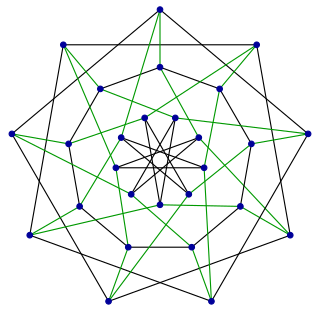
In graph theory, the Holt graph or Doyle graph is the smallest half-transitive graph, that is, the smallest example of a vertex-transitive and edge-transitive graph which is not also symmetric. Such graphs are not common. It is named after Peter G. Doyle and Derek F. Holt, who discovered the same graph independently in 1976 and 1981 respectively.

In the mathematical field of graph theory, the Tutte 12-cage or Benson graph is a 3-regular graph with 126 vertices and 189 edges. It is named after W. T. Tutte.

Italo Jose Dejter is an Argentine-born American mathematician, a retired professor of mathematics and computer science from the University of Puerto Rico, and a researcher in algebraic topology, differential topology, graph theory, coding theory and combinatorial designs. He obtained a Licentiate degree in mathematics from University of Buenos Aires in 1967, arrived at Rutgers University in 1970 by means of a Guggenheim Fellowship and obtained a Ph.D. degree in mathematics in 1975 under the supervision of Professor Ted Petrie, with support of the National Science Foundation. He was a professor at the Federal University of Santa Catarina, Brazil, from 1977 to 1984, with grants from the National Council for Scientific and Technological Development, (CNPq).
Brian Roger Alspach is a mathematician whose main research interest is in graph theory. Alspach has also studied the mathematics behind poker, and writes for Poker Digest and Canadian Poker Player magazines.

The 110-vertex Iofinova–Ivanov graph is, in graph theory, a semi-symmetric cubic graph with 110 vertices and 165 edges.
In the mathematical field of graph theory, a word-representable graph is a graph that can be characterized by a word whose entries alternate in a prescribed way. In particular, if the vertex set of the graph is V, one should be able to choose a word w over the alphabet V such that letters a and b alternate in w if and only if the pair ab is an edge in the graph. For example, the cycle graph labeled by a, b, c and d in clock-wise direction is word-representable because it can be represented by abdacdbc: the pairs ab, bc, cd and ad alternate, but the pairs ac and bd do not.
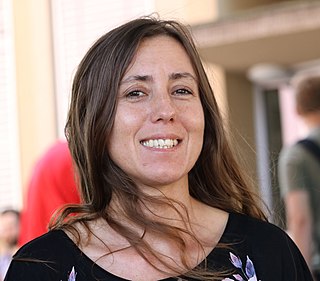
Klavdija Kutnar is a Slovene mathematician. She received her PhD at the University of Primorska (UP) in 2008, and she currently serves as the Rector of the university.
